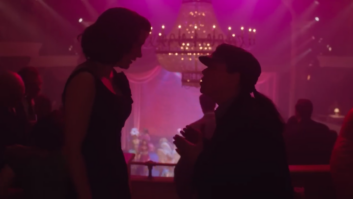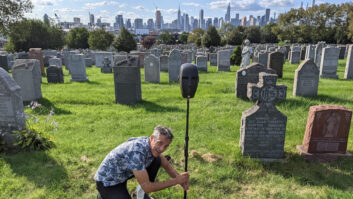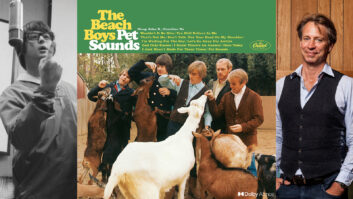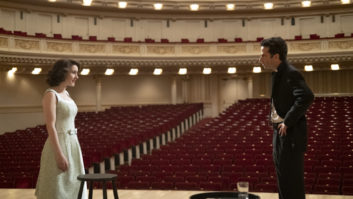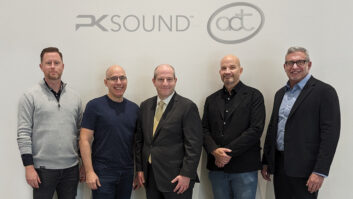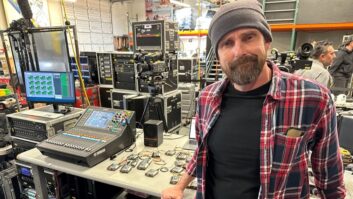
Hollywood was a couple of weeks into pilot season when Los Angeles County announced its “safer-at-home” order in mid-March in response to the coronavirus pandemic. Productions were stopped in their tracks as cities and states nationwide issued stay-at-home mandates. Of the 56 pilot episodes ordered by the five broadcast TV networks this year, the Los Angeles Times reported, only one got made before much of the country went into lockdown.
The shutdown has been devastating for the industry, of course. According to the report in the L.A. Times, pilot season, which runs from late February through early May, is worth an estimated $500 million to the entertainment industry. But what about those shows that were already being broadcast, with episodes for future airing still in the post-production pipeline?
Scott Gershin had been working as supervising sound editor on Mrs. America since the beginning of September 2019 when the March lockdown order was announced. “We had two challenges,” he says. “First, we needed to finish editing and mixing the show to make our air dates. Secondly, we needed to finish shooting ADR, Foley and walla group for episode eight and we hadn’t done anything for episode nine. And episode nine was big. We had completed mixing four episodes before the pandemic and had edited three additional episodes ready to be mixed. We remotely mixed the last five episodes.”
Mrs. America, an FX miniseries from Canadian TV writer and producer Dahvi Waller, known for her work on Desperate Housewives, Halt and Catch Fire and Mad Men, is the story of the battle between feminists and anti-feminists over the Equal Rights Amendment during the 1970s. The show, which aired on Hulu, was recently nominated for 10 Emmy Awards, including for lead actress Cate Blanchett and supporting actresses Uzo Aduba, Margo Martindale and Tracey Ullman.
The ERA was introduced in Congress in 1923 to codify equality between men and women in an amendment to the U.S. Constitution. But it was not ratified by the legislatures of 38 states, or three-fourths of the total, as required by Congressional convention, before the deadline, so the ERA was reintroduced in 1971. It was passed by Congress, endorsed by President Richard Nixon, and by 1977 35 state legislatures had approved the amendment.
Mrs. America follows the so-called second wave of feminists, such as Gloria Steinem (played by Rose Byrne), U.S. Representatives Bella Abzug (Martindale) and Shirley Chisholm (Aduba), and writer and activist Betty Friedan (Ullman), and their efforts to push the amendment past the 38-state threshold. They were ultimately thwarted by the anti-feminist forces arrayed behind housewife and grass roots organizer Phyllis Schlafly (Blanchett), who came to be known as “the First Lady of the Conservative Movement.” Ninety-seven years after the Equal Rights Amendment was introduced, it has yet to be ratified.
Looking Back at the ‘70s
Gershin, a veteran sound supervisor, sound designer and mixer, surely needs little introduction. He was Founder and Executive Creative Director of Soundelux Design Music Group and Executive Creative Director/Supervising Sound Designer and Mixer at Formosa Group before joining Keywords Studios and creating the Sound Lab. His credits over the past 30 years encompass films such as Nightcrawler, Book of Life, Team America, Shrek, American Beauty, Hellboy 2 and Pacific Rim and games including Valorant, Final Fantasy, Resident Evil, Doom and Gears of War. He has a list of awards as long as your arm.
The directing and producing staff of Mrs. America came from feature films and premium television, says Gershin. “Creatively we had similar sensibilities and approach. We wanted to create a lush sonic landscape that immersed you into that period of time. The people and the debates were real. I ended up doing a lot of research. A lot of the historic events were on YouTube. I was amazed at how well the actresses depicted their characters. I wanted to do the same with the soundtrack. I was living in New York during that period of history, so I knew the sounds of that time and place. My instinct was to have rich, realistic background sound effects.”
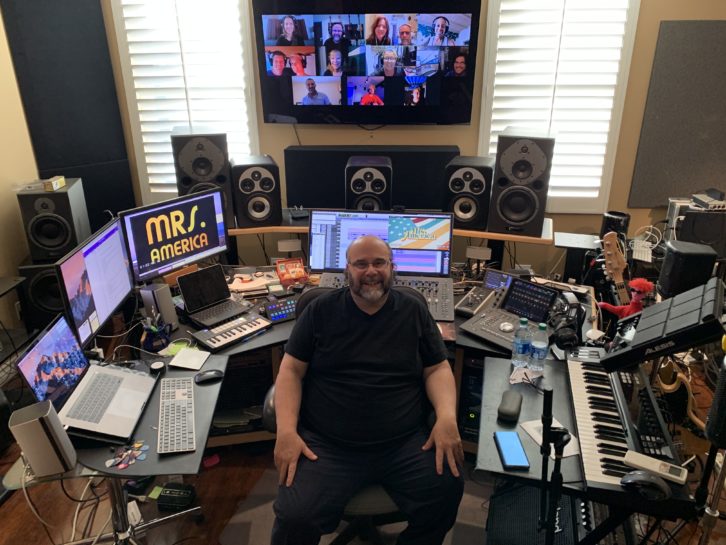
During production the actresses were wearing hard-sole shoes on wood floors. “At times there were these gems of production sound that were so great-sounding. I said, ‘I want to use more of that!’ I wanted that realism, that sound,” Gershin explains. “I didn’t want it super-clean and sterile. I love when Foley sounds like production, not sterile and lifeless, not exactly the same, but has personality. And if it blends with production, you won’t even know it’s Foley.” He brought on Andy Malcom’s Footsteps team to shoot the show’s Foley tracks.
“To me, Foley glues the dialog to the character more,” he says, adding that it grounds the character in reality. “However, there’s a part where Gloria gets into her own head; the character loves to dance, and in that scene, I wanted to get away from realism as she escapes into the music. I wanted her to float. So we transitioned from reality, hearing distant New York, the television, Foley and movement, to surreal, and mixed out all reality leading to a flashback. It’s all about contrast. If our tracks were Spartan before, after the transition and flashback it wouldn’t have been as effective. There wouldn’t have been enough contrast.”
As for the dialog, he says, “I wanted to bring something a little different to the show. It’s a show about women, so I needed the sound of lots of women, in different environments and sizes. This is the 1970s, so it’s not just the general sound of women, but women with different vernaculars, ages, accents, locations, political views; conservative women, liberal women, black women. I wanted to try and replicate the sonic languages of the show to make sure that the walla group and crowds were speaking as they would in the 1970s. It’s a period piece, even though it wasn’t that long ago. It was a different day, a different slang.”
Women’s Voices, Alone and Together
There are no real sound libraries of women’s voices, Gershin discovered, so he had to re-create and record all the crowds the show needed. “I was trying to see if we could get it done on the set, but they just didn’t have the time,” he reports. He booked time at one of the former Todd-AO stages in Hollywood specifically because of its sonic properties
“I used the Loop Squad,” he says, which is headed by Mark Sussman and Patty Connolly. “We were always auditioning and figuring out who would be the best actresses in any given episode. Sometimes I’d want an older voice, sometimes I wanted a much younger voice, or a number of black actresses to portray the women that surrounded Shirley Chisholm and the variety of characters that represent the diverse viewpoints at that time.”
The challenge was to place those voices into a variety of acoustic spaces: convention halls, big parties, small parties, stadium singalongs and other scenes. Rather than use a shotgun mic to record, as would be typical, he says, “I had four or five different mics, depending on the session, which I strategically placed around the room—Sennheiser 8040s and 800s, DPA 5100s, Sanken CSS-5s. I wanted to use the room acoustics to help define the space, so I had some actors far away, facing the wall. I was able to use the room to help take eight, 10, 15 women and make them sound like a hundred.”
For the show, Gershin and his team worked out of Sound Lab’s space in Burbank. “[Scoring composer] Mike Post’s old mix room is my edit room,” he says. The room shares a wall with Stage 6—Post’s former recording room—where Chris Minkler mixed the dialog and music for Mrs. America while Andy King handled effects. As the mixes came together, he says, “We would playback scenes and episodes in my room, which is set up like a giant living room where I have a huge array of different types of speakers, to make sure everything was translating correctly. The mixers did a fantastic job.”
Then along came COVID-19.
Remote Walla and ADR
Gershin was able to finish editing and listen remotely to the show in his well-appointed, 7.1-capable facility at his house. “I was able to prep all the material here before it went to the stage,” he says. “But we still needed to shoot the walla group for episode nine. We needed to find actors that had recording rigs at home. Some of the actors barely had anything. They weren’t sure how to record, or what sample rate to record at—or what a sample rate is.”
The background voice actors—as well as some of the principals, who had to re-record or change some production track dialog—had a variety of gear at their homes, he reports. “They had a large diversity of technologies and mics. Some had shotgun mics, some had large-diaphragm mics and others had mics, like the Apogee, connected to phones or iPads. I had to customize their setups a little bit,” he says. A lot of it was educating the actors on how to record, what recording levels to use, a lot of trial and error, working through distortion and proximity effect issues.”
With no two home situations being alike, Gershin had all the actors set up a recording booth in a closet, where possible, to minimize acoustical differences. “Everybody had unique setups. Some actors built tents. One actress had a giant box she put her head into creating a pseudo iso booth.”
Gershin conducted the sessions—literally, he says, as you might a group of background singers—via Zoom, distributing picture to everyone as a separate feed. “I was sharing my screen and they could shoot against that. They would send me their material and I would listen to it. Ten plus actors recording individually, so every take was 10 tracks, at least. And I was doing a lot of different takes. That ended up being hundreds of tracks.”
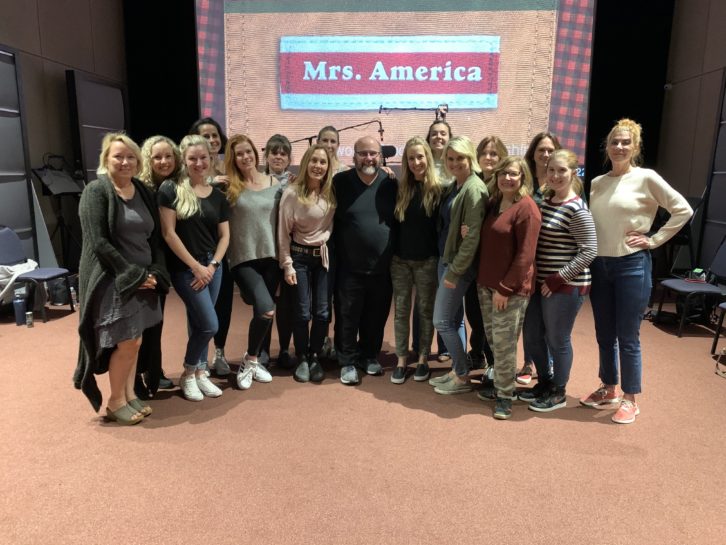
Since most scenes take place in large rooms, Gershin was nervous that the different ambiences of the various home recordings would be tricky to match up. But with some judicious processing, everything worked out fine. “I had to find each person’s acoustical problems and address them,” he explains. “There was a lot of EQing, processing, pitch manipulation, et cetera. But I had to be careful with compression, because that would bring up the room ambience, which in this case I didn’t want. Then I’d add a couple of different reverbs and send it off to the mixers.”
Reverb was added according to the effect that he wanted, he says, adding, “I would sometimes use the sound effects of distant crowds to simulate the reverb and size in episode nine. Overall, since I was recording the loop group with specific acoustic signatures, I didn’t want a lot of reverb to be added in the mix. I wanted to hear all the special details. I wanted words to slightly poke through different parts of the scene, creating a slight spatial shimmer and movement. I like contrast between defocused sounds in back and focused sounds in front. I would place a mono on the left and a different mono on the right, so you hear all these little percolations. When you add reverb, it would smear and defocus the sound; however, sometimes I wanted it to smear. But most of the time I wanted details to poke out like you were overhearing a conversation.”
Gershin remotely recorded a character who plays the mother of Alice, a fictional character played by Sarah Paulson, who was talking to Alice on the other end of the phone. The character’s timing had to be exact, as the picture had already been cut against Paulson’s performance.
“She had a great rig on her phone,” he says. “While I directed her on Zoom, she would record it and then send it to me right away. I would put it in my edit and see if it worked.” If a line didn’t fit, Gershin would apply time compression and other techniques and send it back as a guide track so she could hear the rhythm in which it had to be read. “This was all in real time. Without Zoom and the internet, I don’t know what we would have done.”
Figuring Out Workflow on the Fly
Indeed, the post sound team constantly found ways to meet the challenges of working remotely during lockdown. “Every day there was a weird problem that had to be solved,” Gershin says. “We kept finding creative, last-minute, off-the-cuff ways to get the show done. Many times, the discussion was, ‘Can we keep things going?’ Usually, the answer was, ‘I don’t know, but let’s keep going until we can’t.’”
During the final mixes, “I was working with the mixers from my house. The two mixers were the only people on the mixing stage,” Gershin says, noting that there were a few times where a line of dialog from the walla group would need to be fixed because it wasn’t appropriate for that specific time period of that scene. “I would quickly call up that actor, we would record them and they would send me the updated line. I would quickly edit it at my house, deliver it to the stage, and before we finished notes with the clients the line was remixed into the scene. Turnaround was usually 15 to 30 minutes.”

To manage playback and notes from the film makers during the review part of the final mixes, “We ended up looking at different technologies,” he says. One solution was Streambox, an IP-based video streaming platform. “We were able to securely broadcast to myself, the music editor, the show runner, producer, directors and picture editors. In addition, after our online live sessions, we would also send out Quicktime videos and they could watch and QC at their own convenience both in stereo and 5.1.”
To consolidate the mix, ADR, music and editorial notes, they used a [cloud collaboration] program called Airtable to communicate with each other. “We all would review and prioritize the notes, then the mixers, the music editor and I would address the notes, then have everybody come back for final playback and additional fixes. We would refer to this as our ‘Brady Bunch’ moment.”
For Gershin, one of the high points of the show was the compliment he got from showrunner Dahvi Waller. “She said, ‘I just watched episode nine and I can’t tell the difference between that and the other episodes.’ At the end of the day, we made it all work out.”
